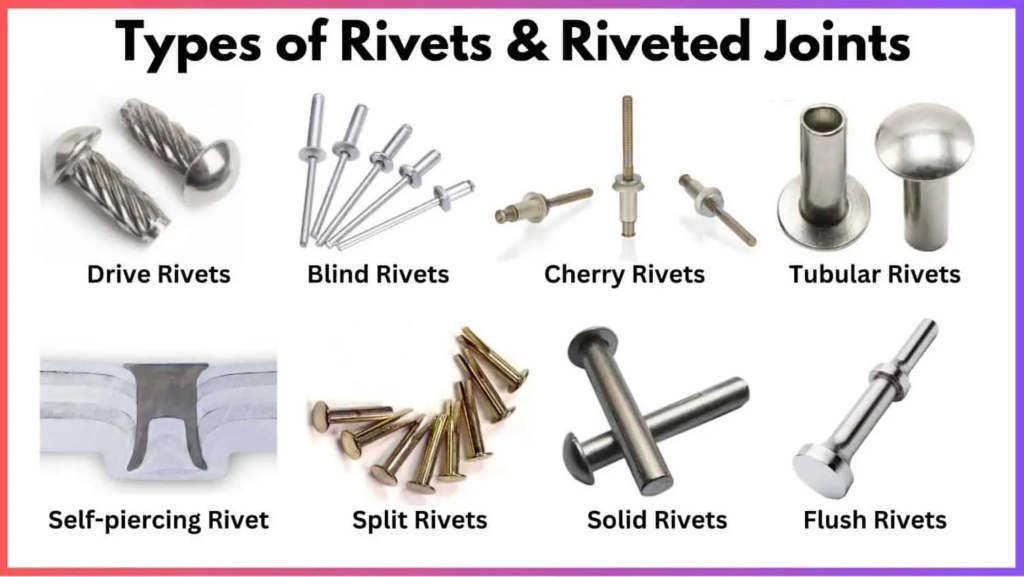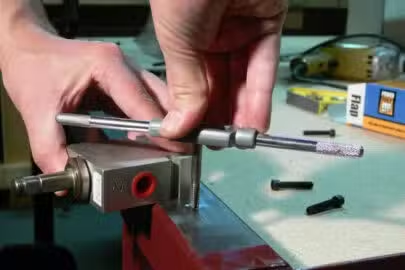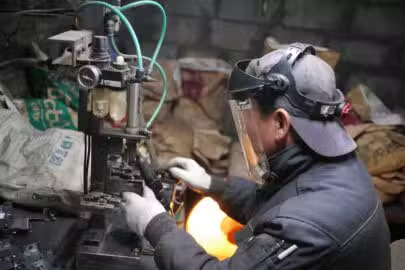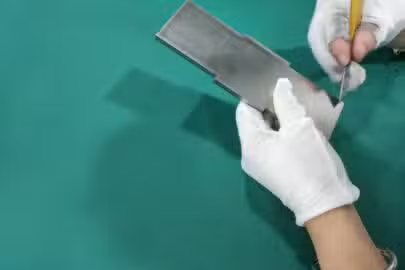Manufacturing and product design professionals rely on essential tools to connect and effectively align components and structures. These tools play a crucial role in assembling these components, and rivets are the most vital of these tools.
Rivets are a universal and low-cost method for fastening two components together. Different types of rivets cater to specific design requirements, materials, applications, and properties, offering exceptional fastening capabilities suitable for light and heavy-duty applications.
This article will explain everything you need to know about rivets, including the types of rivets, the materials used to make them, and their uses. You will also learn how several industries apply riveting.
Definition of Rivets
A rivet is a mechanical fastener well-known for securely joining or fastening two or more components, creating a lasting and sturdy connection. This fundamental element in engineering typically consists of a cylindrical shaft with a head at one end and a tail at the opposite end. The riveting process involves passing the tail end through pre-drilled holes in the components intended for connection. Subsequently, the opposite end is deformed or “headed,” creating a second head and effectively securing the components.
How Does a Rivet Work?
Various methods can be used to employ rivets. An installed rivet is drilled, placed, or punched into a hole, and the tail is firmly deformed to hold it in place.
Typically, the rivet undergoes deformation by pounding or smashing the tail, flattening the material, and increasing its diameter. Once the pounding is complete, the tail turns into a dumbbell shape, seamlessly completing the rivet joint.
The riveting process, a familiar yet critical procedure, involves several key steps for a robust and enduring connection.
Hole Preparation
In this process, a hole is drilled or punched into the location or parts requiring riveting. While punching may suit thin plates, drilling is preferred for thicker plates and parts. Pressurized methods are employed for punching, with drilling being the method of choice for large-pressure vessels.
Hole Dimensions
The rivet hole is approximately 1.5 times larger than the diameter of the rivet. Removal of burrs and chips is essential to achieve a tight plate joint.
Rivet Placement
The rivet is inserted into the prepared hole, with the tail deformed. The tail portion expands about 1.5 times its shank diameter, ensuring a secure fit.
Riveting Techniques
Manual riveting is an option for small applications, often involving a substantial blow using a hammer to provide thrust on the rivet. Alternatively, a pneumatic hammer is employed to streamline the riveting process for larger applications.
Materials Utilized in Rivet Manufacturing

Rivets, essential fasteners in various applications, are crafted from diverse materials tailored to specific needs. A detailed exploration of these rivet-making materials is provided below:
Aluminum
The most prevalent choice is aluminum rivets, which are prized for their lightweight nature and impressive resistance to corrosion and weathering. Their malleability makes them easily deformable during riveting, facilitating installation with head shapes designed for hand-operated rivet machines. The aluminum quality is particularly advantageous for installing blind rivets in diverse settings.
Stainless Steel
Stainless steel rivets boast exceptional resistance to corrosion and weathering. Due to their hardness, however, installing stainless steel rivets with hand-operated tools proves challenging. Pneumatic rivet guns, on the other hand, achieve optimal results, especially when working with structural rivets.
Copper
Copper rivets are distinguished by their excellent electrical and thermal conductivity. Additionally, copper’s relative ease of forming enhances its appeal. Copper rivets find their place in scenarios where conductivity is crucial, which makes them suited for various types of rivets.
Steel
Carbon steel rivets exist in both solid and hollow shank forms. Installation necessitates pneumatic or hydraulic equipment, showcasing diverse rivet installation methods. Low-carbon steel is favored for its elasticity, offering a more pliable alternative to rigid, high-carbon steel in various structural rivet applications.
Brass
Brass, an alloy of zinc and copper, is characterized by exceptional corrosion resistance and strength. It also does not spark, which makes it particularly valued in the oil and gas industry. Brass rivets serve well in environments where non-sparking properties are critical. Additionally, their aesthetic appeal makes them a preferred choice in various settings, highlighting the aesthetic considerations for fasteners.
Advantages of the Riveting Process
The riveting process offers many advantages, contributing to its widespread application and enduring popularity in various industries. Here are the significant benefits:
- Cost-Effectiveness: Riveting is an economical method, with cost-effectiveness stemming from efficient and affordable production processes.
- Versatility in Material Compatibility: A notable advantage of riveting is its versatility, as it allows for joining ferrous and non-ferrous materials. This flexibility extends beyond metals to non-metals such as wood, plastic, and asbestos sheets.
- Compatibility with Dissimilar Materials: Unlike welding, which typically requires similar materials, riveting transcends this limitation. It facilitates joining dissimilar materials, providing a versatile solution for diverse applications.
- Environmental Friendliness: Riveting is an environmentally friendly process, producing no fumes or gases, in stark contrast to welding. This eco-conscious attribute aligns with contemporary environmental standards.
- High Shear Strength and Fatigue Resistance: Riveted joints boast remarkable shear strength and exhibit excellent fatigue resistance, ensuring the longevity and reliability of connections subjected to dynamic forces.
- Location Flexibility: Riveted joints can be crafted without location constraints, providing flexibility in arranging and positioning components.
Disadvantages of Riveting
While riveting offers numerous advantages, it is essential to consider its limitations and disadvantages for a comprehensive understanding:
- Labor Time Intensiveness: The riveting process consumes more labor time than welding, requiring meticulous attention and effort.
- Additional Operations and High Labor Costs: Riveting entails supplementary operations, including layout and drilling, increasing the labor costs of preparing riveted joints.
- Potential Weakening of Cross-Section: Introducing holes in the material during the riveting process may weaken the plate’s working cross-section, necessitating additional thickness to compensate for potential structural concerns.
- Metal Consumption and Overlapping: Riveting may increase metal consumption due to the need for additional thickness and overlapping of plates to address potential weaknesses associated with the drilled holes.
- Stress Concentration at Rivet Holes: The rivet holes in metal plates can concentrate stress, posing a challenge in specific structural applications.
Types of Rivets Used in Manufacturing

Each rivet type is meticulously designed to cater to specific applications, ensuring optimal performance and reliability. Here are the main seven types of rivets used in manufacturing:
Solid Rivets
Solid rivets, commonly known as round rivets, are the most prevalent type due to their simplicity and reliability. These rivets, often termed round rivets, are fundamental in joining materials. Depending on the rivet’s softness and size, they are easily manipulated using a rivet gun or hammer.
Solid rivets boast high strength and durability, constructed with a solid shaft and a head typically made of copper, steel, or aluminum. With variations in head types, such as 100-degree countersunk or round universal heads, solid rivets find extensive use in critical applications, notably in the structural components of aircraft., where they are instrumental.
Blind/Pop Rivets
Blind rivets, also known as POP rivets, are cylindrical fasteners designed for installation in drilled holes; they consist of a tubular structure with a head and a mandrel running through its center. Renowned for superior shear and tensile strength, they resist vibration, enhancing joint integrity through extensive blind-side expansion. The term “blind” denotes the inaccessible side where the blind end expands, and the mandrel snaps off, creating the joint.
They are commonly applied in military, aerospace, and electronic applications. These rivets are inserted into pre-drilled holes in the parts to be joined, and a riveting tool is employed to push the mandrel through the rivet. The resulting compression force expands the tube, effectively locking the sheets.
Drive Rivets
Similar to blind rivets, drive rivets feature a mandrel through their center. But, drawing the mandrel through the rivet requires a distinct tool. These rivets can be secured with a hammer and possibly a backing block to insert the mandrel into the rivet body and fasten the parts. Drive rivets are suitable for applications where holes do not extend through the entire block, panel, or metal sheet. They often hold panels in place or secure nameplates in bind holes.
Self-Piercing Rivets
Distinct from other rivets, self-piercing rivets eliminate the need for pre-drilling holes in materials. Equipped with a chamfered poke or bevel drill, these rivets create a material hole by piercing the topmost layer, leaving the lower layer partially pierced. The rivet’s tail then spreads and interlocks into the base sheet, forming a low-profile button. Particularly favored for high-stress applications, self-piercing rivets excel in joining dissimilar materials, such as steel and aluminum, which are challenging to weld.
Split Rivets
Split rivets, also known as bifurcated rivets, have a split shaft with sharp ends, allowing them to pierce materials without pre-drilled holes. Resembling self-piercing fasteners, split or bifurcated rivets can be suitable for joining soft materials like wood, plastic, and leather. While not recommended for critical applications, they find utility in home repair work.
Featuring sawed bodies or splits, these rivets possess sharp tips facilitating material hole creation. The self-piercing rivet (SPR) in the split rivet family joins multiple layers without pre-drilled holes, offering versatility in connecting mixed materials or aluminum.
Tubular Rivets
Tubular rivets are characterized by their generic tubular structure, encompassing a head, shank, and partially hollow tube. Ideal for fastening thin sheets of materials like plastics, leather, and sheet metal, they also serve in pivot points requiring movement.
Available in various configurations, these rivets typically have a head on one end and a hollow side passing through the pieces to be joined. Cold forming connects the field head to the hollow side, necessitating highly ductile metals with low strength. Tubular rivets find popularity in commercial applications and electrical devices.
Flush Rivets
Also known as countersink rivets, flush rivets are designed for external surfaces to ensure an aesthetically pleasing appearance and minimize aerodynamic drag. Featuring countersunk heads and holes, they are well-suited for finished metal surfaces requiring minimal visibility. Due to their flush appearance, flush rivets are instrumental in aerodynamic applications.
Here’s a table summarizing the key characteristics of the types of rivets.
| Rivet Type | Characteristics |
| Solid Rivets | – Simple and reliable- Oldest form of joining materials- Consists of a solid shaft with a head- Used in critical applications like aircraft structures |
| Blind/Pop Rivets | – Cylindrical fasteners with a mandrel- Superior shear and tensile strength- Resists vibration for enhanced joint integrity- Ideal for military, aerospace, and electronic applications |
| Drive Rivets | – Feature a mandrel through the center- Requires a distinct tool for mandrel insertion- Suitable for applications with incomplete holes |
| Self-Piercing Rivets | – Eliminate the need for pre-drilled holes- Chamfered poke or bevel drill creates a material hole- Ideal for high-stress applications and joining dissimilar materials |
| Split Rivets | – Split shaft with sharp ends for piercing- Suitable for joining soft materials like wood, plastic, and leather- Similar to self-piercing rivets but not recommended for critical applications |
| Tubular Rivets | – Tubular structure with a head and partially hollow tube- Used for fastening thin sheets of materials like plastics and sheet metal- Popular in commercial applications and electrical devices |
| Flush Rivets | – Also known as countersink rivets- Designed for external surfaces for aesthetic appearance- Minimizes aerodynamic drag- Suited for finished metal surfaces requiring minimal visibility |
What are Rivets Used For?

Rivets are crucial in different industries, providing a robust and secure fastening method for joining wooden or metallic materials. They offer advantages over screws of similar diameters, making them valuable in various applications. Here are some industries where different types of rivets find extensive use:
Construction and Joints
Rivets are extensively used in construction due to their efficiency in joining different parts of structures and machines. They serve as reliable fasteners, enabling the connection of various materials, including wood, to construct lockers, cabinets, and shelves. Examples of rivet types used in this industry include:
- Solid rivets are commonly used for structural joints where high strength is required. They are ideal for joining wood, metal, and plastic.
- Blind Rivets: These are useful in applications where access is only available from one side, as they can be installed without access to the back of the workpiece.
Automotive Industry
In the automotive sector, rivets are crucial in assembling chassis components, body panels, and various parts. Their versatility in fastening materials with different properties, such as steel and aluminum, makes them valuable in automotive manufacturing. Rivets exhibit excellent resistance to vibration and fatigue, contributing to the creation of high-strength applications in automobiles. Examples of rivet types used in this industry include:
- Pop rivets (blind rivets) are quick and easy to install, making them suitable for assembly-line processes. They are often used for joining materials with different properties, such as steel and aluminum.
- Structural rivets: Specifically designed for applications where high strength and load-bearing capability are essential, structural rivets are commonly used in chassis components.
Jewelry Industry
Jewelry manufacturers use riveting as a cold joining method for efficient connections in their operations. Riveting allows for cold connections using bare metal forming techniques, instructional videos, and standard tools, eliminating the need for soldering in jewelry fabrication. Examples of rivet types used in this industry include:
- Tubular rivets are commonly used in jewelry manufacturing due to their neat appearance and ability to connect firmly to cold joining applications.
Sports Equipment Manufacturing
Rivets find extensive use in the sports equipment industry, where they are employed to join components like skateboards, bicycle frames, and ski bindings. Their high strength and durability make rivets an ideal choice for applications in sports equipment manufacturing. Examples of rivet types used in this industry include:
- Tubular rivets: These provide a clean and decorative finish, making them suitable for applications where aesthetics are essential, such as sports equipment.
Aircraft Construction and Repair
Aircraft manufacturing uses riveting to join solid and durable materials to achieve strong alignment and structural integrity. Riveting is essential for connecting aluminum alloys in aircraft, ensuring strength and neatness in construction or repair. Riveting becomes indispensable for aircraft repair or construction when reaching tightened structures is challenging. Examples of rivet types used in this industry include:
- Flush head rivets: These are designed to create a smooth surface when installed, preventing any protrusions that could cause drag. They are commonly used in aircraft manufacturing for aerodynamic reasons.
- CherryMax Rivets: Specifically designed for high-strength applications in aircraft construction, providing excellent shear and tensile strength.
Home Building
Rivets play a vital role in home construction, particularly in fiberglass roofing, where they securely hold the glass together. They effectively construct gutters, offering a more dependable fastening method than nails for metal sheets in home building projects. Rivets contribute to creating various structures, including window blinds, wind guards, doors, and hanger straps, enhancing durability and reliability over time in home construction. Examples of rivet types used in this industry include:
- Grip-Tite Rivets: These are suitable for attaching metal sheets, such as those used in roofing. They provide a secure grip and are resistant to vibration and weathering.
- Tri-Fold Rivets: These are used in applications requiring a broad, low-profile head, making them suitable for joining materials in window blinds and other home construction projects.
Conclusion
Rivets serve as pivotal connectors, aligning components in structures with universal appeal. From solid rivets to blind rivets, each type offers a versatile, cost-effective solution. The meticulous riveting process involves steps from hole preparation to joint formation, highlighting its attention to detail.
Rivets are timeless, adaptable elements that weave through manufacturing processes and applications. The riveting process can be complex, especially when producing high-quality custom metal rivets. At Zintilon, we have experts with the right amount of experience to help you succeed in your project and achieve your goals.
FAQ
What is a rivet?
A rivet is a sturdy mechanical fastener with a cylindrical shaft that joins components by passing its tail through pre-drilled holes and deforming the opposite end.
What are the Types of Rivets?
Common types include solid, blind/pop, drive, self-piercing, split, tubular, and flush rivets, each tailored for specific applications.
How are Rivets Commonly Used?
Rivets are widely used to securely fasten materials in various industries, including construction, automotive, jewelry, aerospace, sports equipment manufacturing, aircraft, and home building. They offer versatility, compatibility with different materials, and high shear strength.
Read More
- Top 6 Medical-Grade Materials You Should Know – Zintilon
- CNC Milling vs CNC Turning: A Detailed Guide – Zintilon
- Definitive Guide on Sheet Metal Materials and Their Applications – Zintilon
- A Guide to Rapid Prototypes and their Benefits – Zintilon
- Automotive Car Chassis: Structure, Types, And Design Trends – Zintilon




